HMS Queen Elizabeth has started having her Phalanx Close-In Weapons Systems (CIWS) fitted.
The Phalanx Close-In Weapons System is designed for use as an anti-aircraft and anti-missile defence, the vessel also carries 30mm Automated Small Calibre Guns and Miniguns for use against fast attack craft.
The system is radar-controlled and is said to provide a “last chance” defence for ships against anti-ship missiles and aircraft. It automatically detects, tracks and engages threats. It features a 20mm M-61A1cannon, search and track radar and FLIR in the Block 1B model. To date, the United States Navy and 20 other nations have purchased more than 850 Phalanx systems.
It is……. a Phalanx 1B
A rapid-fire radar and electro-optical guided gun, the first of three to be fitted.
Featuring a 20mm barrel it is capable of firing 4,500 rounds per minute against anti-ship missiles and a range of surface threats.#Phalanx #CIWS #CapabilityIncreased pic.twitter.com/LbIEjHw6uL
— HMS Queen Elizabeth (@HMSQNLZ) February 6, 2019
HMS Queen Elizabeth returned to Portsmouth last year after completing a number of firsts for the ship, notably F-35 trials.
The Royal Navy said in a release that during the Development Trials, F-35 jets conducted 202 takeoffs from the ship’s ski ramp, 187 vertical landings, and 15 shipborne vertical landings —a landing technique unique to the UK. They also dropped 54 inert bombs, testing the weight loading in a variety of weather conditions and sea states. The operating envelopes will be further expanded during Operational Trials, scheduled for next year.
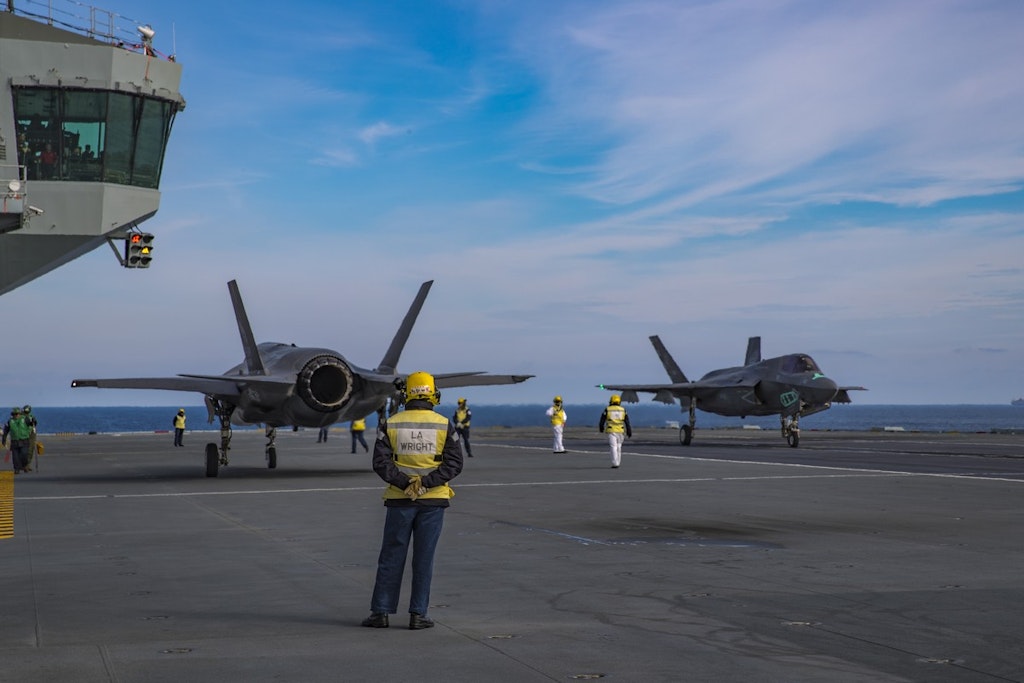
Defence Secretary Gavin Williamson said:
“HMS Queen Elizabeth’s inaugural deployment to the US has not only marked the return of the Royal Navy’s carrier strike capabilities, but also strengthened our special relationship with US forces. A true statement of our global reach and power, this ship will serve the United Kingdom for generations to come, keeping the nation safe and supporting our allies as we navigate increasing threats.”
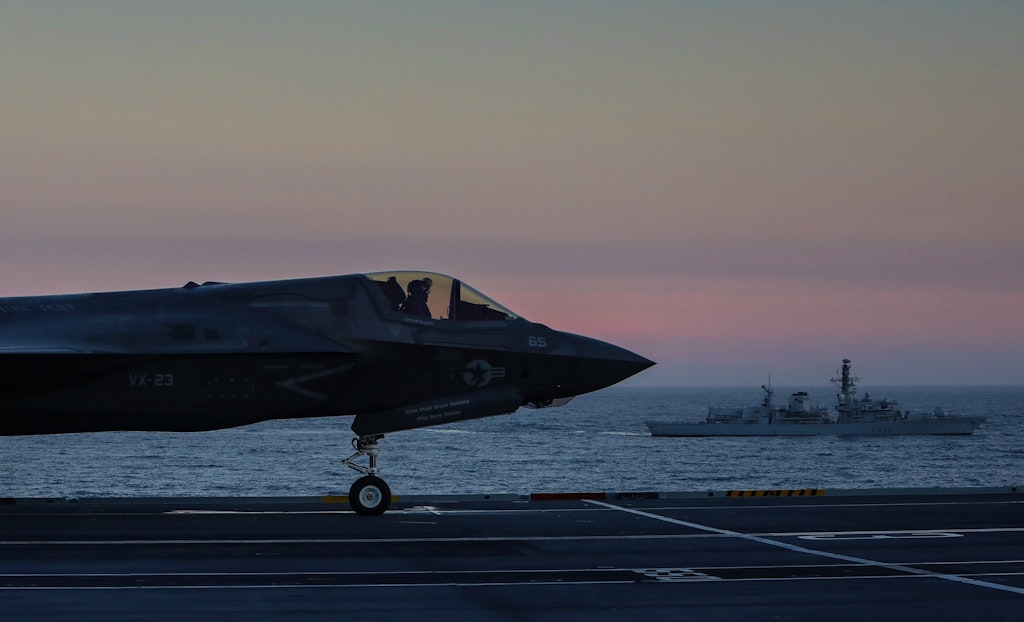
Captain Nick Cooke Priest summed up the deployment, saying:
“The WESTLANT 18 deployment has been a real success; and let’s not forget that we are just a year on from the Ship being commissioned and accepted into service.
The main effort – Fixed Wing Flying trials have delivered outstanding results, which is testament to the co-operation, hard work and dedication of both the Ship’s Company and the US Integrated Test Force, assisted by the US Navy and US Marine Corps.
Their combined efforts have put us in an excellent starting position for next year’s Operational Testing. The Ship has proudly flown the flag for the UK across the Atlantic.”
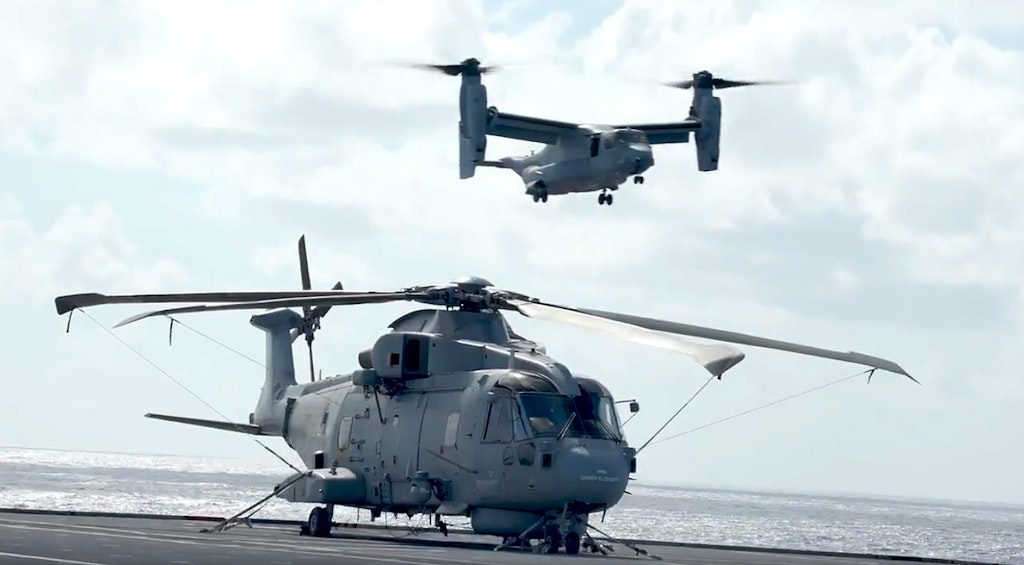
Commander Air onboard, Commander James Blackmore oversaw the flight trials and said:
“Since the ship sailed from build only 17 months ago we have operated Fixed Wing – most notably the F-35B – Rotary Wing and the Tilt Rotor MV-22 Osprey – 9 different aircraft types in all. We have proved the incredible design of the Queen Elizabeth Class of ship and the partnership with the F-35B.
In that combination, we have something very special that will provide significant operational capability for decades to come, strategic choice for our government and a Task Group focus for the Royal Navy; we are truly back in the Super Carrier era.”
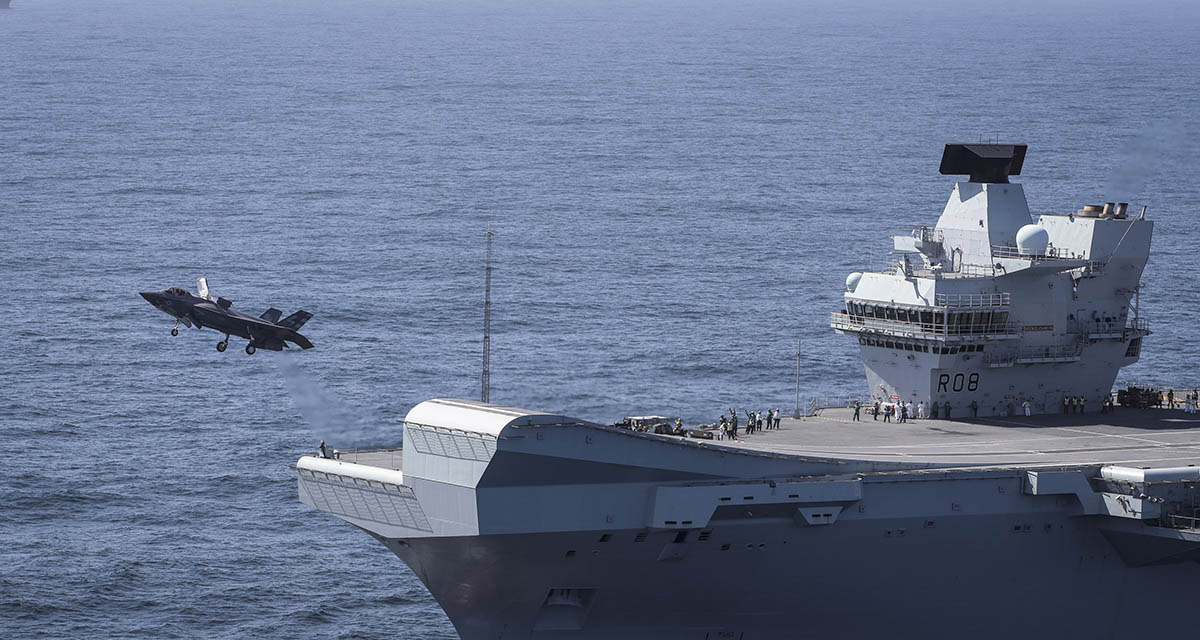
The deployment was also the first for the reformed UK Carrier Strike Group staff according to a Royal Navy news release, headed up by Cdre Michael Utley, who said:
“This has been an extraordinarily successful deployment on the Royal Navy’s journey to full Carrier Strike capability. It has once again demonstrated the strongest of relationships with our closest allies in the US and will underpin future work as we re-introduce fixed wing aviation at sea.
The design of HMS Queen Elizabeth, specifically built for the immensely capable F-35B Lightning II, has enabled outstanding progress which will form the basis of Operational Testing in 2019.
The other Task Group units deployed, including HMS Monmouth, our new Royal Fleet Auxiliary Tanker RFA Tidespring and the Merlin Helicopters from 820 and 845 Naval Air Squadrons, as well as Royal Marines and members from our sister Services, have all contributed to this significant success.”
The Task Group comprised HMS Queen Elizabeth, HMS Monmouth, RFA Tidespring and aircraft from 820, 845 and 814 Naval Air Squadrons, as well as Royal Marines from 42 Commando and supporting units from the US Navy and US Marine Corps, say the Royal Navy.



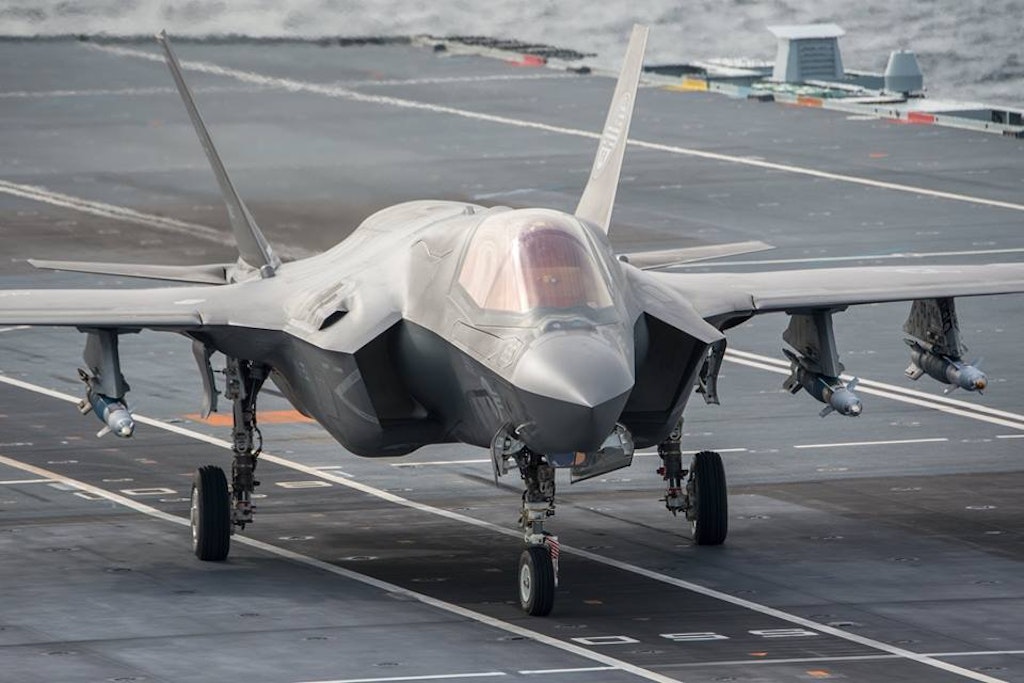
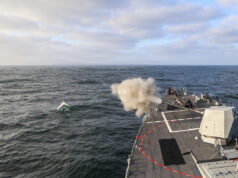
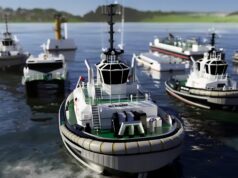
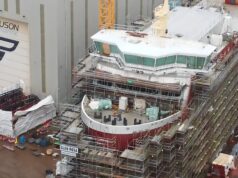
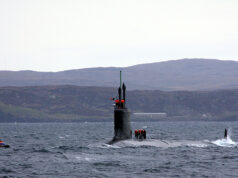
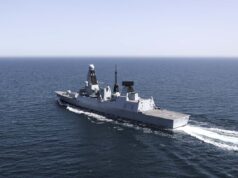

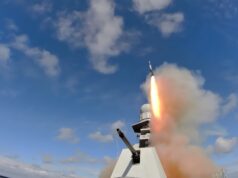
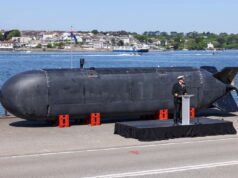
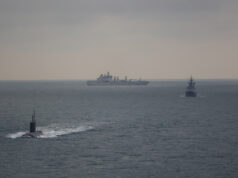
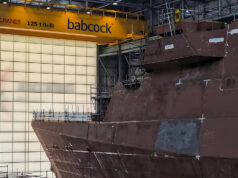

Cue meltdown on UKDJ!
An emotive subject for many for months.
Snigger…
Why not Goalkeeper system, isn’t that the better all rounder of the two?
This has been covered on here before by Gunbuster.
Phalanx is bolted on where’s Goalkeeper needs to penetrate the deck.
Ahh thank you 🙂
(I had assumed it was down to cost and the UK being cheap)
That’s the real driver. These will be plugged into ‘spots’ ready prepared for them. As well as power points there will be some plumbing for water for cooling too. ‘Deck penetration’ shouldn’t be a problem on a brand new design of such a size.
Phalanx is a minimum. Something over 30mm would be preferable.
Really?
The end effect of a tungsten sabot dart on a missile is not that different between 20mm and 30mm. The muzzle velocity of the Vulcan 20mm is virtually the same as the Avenger. Phalanx has more ammunition to fire off. Vulcan also has a higher cyclical rate. The engagement range is slightly further out for Goalkeeper but against a sea skimmer when you are at 3,500 meters vs 2,600 it is brown trousers time any which way you look at it.
Goalkeeper has fallen behind the curve, is hasn’t had the same investment Phalanx has over the last couple of decades. Phalanx in Block 1B form is arguably a more advanced and superior system to Goalkeeper with greater flexibility in operation and use.
GLKR was removed from service a few yrs back when LUST was decommissioned. Now, Commonality prevails! T45, LPH, QEC plus future fits to T26, poss T31? it enables the dustribution of trained Engineers, require one training stream for the RN.
I fully admit I am no expert at all. But it appears to this ignorant observer that the Phalanx is on the verge of obsolesence. Against a Brahmos 11 or other hypersonic ASM, Phalanx may only place 50 to100 projectiles in the knock down zone, against a jinking target travelling at 1 mile a second. Would a twin gun 57mm or 76 mm turret system have more chance, firing smart munitions saturating a kill zone with pre fragmented air bursts?
Phalanx is not obsolete against lower end threats which it may well still face for years to come. As for hypersonic weapons I suspect, for the time being, the best we can hope for is that the RN has invested in good EW systems a la the new block 2 AN/SLQ-32(V)6 used by the USN.
There have been proposals to change calibre from 20 to 25mm. Sadly, they went nowhere.
I do wish QE/PoW would get an anti torpedo system.
It has/Will SSTD 2170
50 phalanx systems are being upgraded for UK service. I would imagine that all the navies, including the USN who use phalanx are still happy with the system.
http://www.defense-aerospace.com/articles-view/release/3/196186/us-clears-phalanx-upgrade%2C-mini_submarine-sale-to-uk.html
There’s a limit to the effectiveness of using bullets/shells, a larger calibre with smart munitions would undoubtedly be better than the current Phalanx, but then you might as well just have point defence missiles. The next step will be lasers, have a look at the UK dragonfire consortium or the USS Ponce testing in the US.
Even “if” a hypersonic missile has the capability of jinking, it will still be heading directly for the ship in an ever decreasing cone. The Phalanx 1B fires 75 tungsten (depleted uranium) rounds a second in a tight pattern out to an effective range of let’s say 2km. At this point, the incoming missile cannot do a lot of jinking manoeuvres this close to the ship, because there is a chance it will miss the target. The Phalanx will put a stream of tungsten in its path and the collision speeds will be immense. The tungsten rounds would probably pass through the missile, destroying it in the process.
There may be two issues, 1 – does the Phalanx hold sufficient rounds to deal with more than one hypersonic missile and 2 – the system has a maximum target engagement velocity, if the missile is travelling faster than this limit it will not engage. I’m pretty certain the the US Navy in particular will not have this system fitted to their ships if it could not engage a Brahmos type of anti ship missile, although SeaRAM is starting to be fitted to more ships.
I don’t believe the system has been used to defend a ship yet. It has proven itself against target drones and the odd aircraft by mistake.
DaveyB. I agree with everything you have said but there is one serious ommission. The stream of projectiles will certainly be effective in a direct line. However an incoming Brahmos 11 will, unless flying right down the throat of the CIWS, will be at a changing angle to the line of fire. At 2000 meters the insection angle of missle and projectiles would be about 3deg. At 600 meteres the intersection angle would be about 11deg. So a missile would not be travelling down the stream but it would be passing across the stream. This means that if the CIWS stays at a fixed angle, it only has just over the length of the missile to target. The gun has therefore to track the target. If the max engagement range is say 2000m and the minimum is 400m, the missile will take 1 sec to travel this 1600m. The CIWS will fire 75 rounds which will be spread over 1600m. So it seems the chances of hitting a Brahmos11 with a SINGLE round is 1in22.
Indeed. Isn’t that why the RN generally chooses to place the CIWS P & S approximately amidships, i.e. at the centre of the radar return, thereby minimising the intersection angle. Unlike various other navies (who don’t have the combat experience) who place them on the centreline fore & aft.
Phalanx tracks the target and the fired rounds. It alters the aim point to bring the rounds onto the target. A changing profile is not an issue. On a multi mount fit all of the mountings are networked and “talk” with the threat analysis algorithms assessing which mount has the best hit chance and allocating it accordingly, all automatically with no hands on.
The hit/kill probability is calculated for the CIWS I have worked on by the number of rounds you can get within a set area centred around the target. The mount will fire until it achieves this . So you may get a long or a small burst of rounds at the target. The mounts computer decides if a kill has been achieved.
The number of rounds to be delivered to that area for a kill is in the tens of rounds and the area is really very small. In the RN during trials you always shoot at a crossing target. You dont want any debris from the drone or towed target hitting you and a crossing target will mean that debris passes ahead or astern of the ship.
The RN found this out the hard way in the early days of phalanx use when a T42 named after a NE UK City parted the tow wire on a towed target which then came inboard into the engine intakes.
Hi John, I agree. I was trying to make it as simple as possible with the ship not manoeuvring and being attacked from abeam of the ship and therefore not using trigonometry and deflection angles to get the point across. When active a Brahmos missile will have a lot reflective scatter from abeam of the QE to lock on to due the ships size. Therefore, it is critical that Phalanx are placed to cover this large side area.
The standard Brahmos travels nearly at Mach 3 (@20C @Sea Level) which is 3704kph, The next generation of Brahmos is reputed to travel at Mach 5 (@20C @ Sea Level) which is 6174kph, or to put it more rudely 6173m/s and 10,290m/s respectively. This means at the 2k mark there is about a 1/3 of second before it hits the ship at the missile’s slowest speed. Therefore even if the missile is approaching down the throat of the Phalanx, there is very little time to not only track the target, but make the decision to fire. The gun must fire early to ensure that the rounds and missile meet at the 2k mark.
For sub-sonic missiles Phallanx makes more sense. Which is the reason why Phalanx will be fitted just a ahead of the bridge on the port side and directly opposite on the starboard side, as they are near the centres of reflective mass. I think having only the one on the stern is not adequate, as it cannot cover the starboard side las it can for the port side (depending on port or stbd fitment). The guns are autonomous so will double up engaging a target, if it is within its target envelope. There are a number of pictures on the web which show this.
I know the ship will be fitted with chaff and probably an active RF jammer, but looking at the maths, I’m not certain that Phalanx will be able to handle more than two Brahmos style missiles approaching from the same side at the same time. This is one reason why SeaRAM may be a better requirement, as it has a better engagement range.
I know that the discussion on whether the ship requires its own SAM system has been discussed (lots) before. The theory being that the F35s, T45s and T23/26s being in attendance should be able to deal with most threats. I’ve change my mind, relying on Phalanx is not good enough! You want as many SAMs as can be carried, by all your ships.
I think it was Tom Clancy’s Red Storm Rising that first introduced the coordinated swarm attack to the public on a carrier battle group; using first decoys then followed up by the real anti-ship missiles. This used up the CAPs missiles and the battle group had to rely on their own defences. There will always be leakers as the systems are not totally infallible. Therefore does it not make rationale sense to protect our primary asset as much as possible with its own SAM system, be that SeaRAM of SeaCeptor? I fully understand the FOD problem, but rather a FOD problem than jumping into a life-raft from a sinking carrier!
I think you need to check your math.
I’m not in the habit of trolling the web, pointing out other people’s mistakes, in fact, I usually troll those who do. However, while it was plausible to me that your low m/s should match your high Km/h (I notice these weird occurrences and patterns all the time), being out by 1 digit seemed strange to me. When related numbers work out that close then the digits usually end up being exactly the same, 1 digit out just never happens. Then I noticed that the m/s digits read larger than the km/h digits when they should always be smaller.
While Mach 3 is indeed 3,704Km/h, you’re out by a factor of 6 on your m/s. 3,704,000m/3600s (60×60) = 1,029m/s.
6,173 ÷ 1,029 = 5.99.
Again, Mach 5 does indeed = 6,174Km/h, but again you’re out by a factor of 6. 6,174,000m/3600s = 1,715m/s.
10,290 ÷ 1,715 = 6.
Interestingly, your high speed figure was exactly 10 times what your low speed figure should have been.
Of course, this means that the gun has 6 times as long to do its job, with the missile taking almost 2s to cover 2 km.
That aside, I’ve learned a lot from you and everybody else who has posted here.
I do have 2 questions though. According to the article QE is “also fitted with 30mm automated small calibre guns and miniguns for use against fast attack craft”.
What is the difference between automated miniguns and the Phalanx CIWS?
What is the calibre of each?
You dont Jink at hypersonic or near hypersonic speeds.
You do that and you miss.
The flight control system cannot respond quickly enough to the attitude change of the target.
To all I regret using the word jink. It did seem that there was no scope for a hypersonic missile to do this in a terminal phase. Subsonic yes. It was from a report Defence News. However, given the times involved I still think the Phalanx simply cannot be relied on to deliver the required number of projectiles at the place in time required. It would not be surprise if the seekers on possible hostile missile are being programmed to avoid flying directly into the line of fire of a CIWS. Alternatively one fractional a change of direction for the missile at about 2500m +/- would screw up the CIWS solutions. Indian Kolkata class destroyers have 16 Brahmos. It is almost certain that an Nato ship would face more than a single hypersonic missile. If there are reasonable doubts about knocking down a single Brahmos11, what chance 2 or 3 inbounds. My orignal post postulates rather than hitting the missile, would it not be better to let the missile hit the hailstorm.
16 missiles mean nothing …they are just decoration if you dont have over the horizon targeting.
If you cannot find the target in the first place then its a big assed ocean to fire blindly into. The best practise is to kill the shooter , or its mid course guidance source before the missiles are shot. To do that the F35 will be used way before you get into AAW , soft and hard kill territory .
The Royal Navy have a very capable anti torpedo self defence system.
SSTD.
http://www.defense-aerospace.com/articles-view/release/3/52113/royal-navy-introduces-anti_torpedo-system-(jan.-28).html
4500 r/p/m is impressive but does anyone know the magazine size? And for how long these can keep firing before they melt
Let’s be honest, QE has the best air defences money can buy and it’s got nothing to do with 3 little “when all else fails” guns.
QEs will live or die on how effectively it’s escorts and air wing works, that’s where the money and thought needs to go, not slightly better last ditch guns, because if a QE needs to lean on them it’s all probably got to the point where the carriers going to end up a mission kill and not be able to complete its mission.
Stopping a threat getting close is what’s needed not letting it so close that your finished launching aircraft until everything is cleared away.
Completely rational and logical argument – please stop it as that has no place in the UKDJ comments section!
Yup, You pretty much nailed it there mate.
Well said.
Finally, a well informed observer, gents take note.
An Emotive subject much covered here and elsewhere over the years together with, “What Aircraft” and “Should have had Cat’s and Trap’s” and, “Should have Kept the Harriers”
What we actually have Is a “Layered Defence” including Subs, F35b’s, Type 45’s, type 23’s/26’s Merlin’s and Wildcat’s. Each of these have their own Defensive weapons, not forgetting Radar and other systems and from what I can tell, there would be one hell of a fight to get anywhere near one of the Carriers, all things considered.
Or that’s what the MOD believe.
Still no progress on a buddy system for air to air refuelling for naval F35 aircraft. These are expensive aircraft to lose for lack of such a basic need. They cannot just divert to the nearest airfield.
Can the tiltrotor fly fast enough to allow an F35 to accept and transfer fuel from the donor aircraft?
Robert, point of order. The RN have not been particularly good at defending their ships since about 1915. A painful lesson has to be learned every generation or so
Land Ceptor on the flight deck would be a nightmare. Apart from a collision hazard, every time you launched you’d have to carry out a fod check.
Gavin Gordon – surely the inconvenience of a ‘Fod Plod’ would be preferable to a Sinking Carrier ?
Wonder why no SeaRAMs?
Not used by the Royal Navy
Good god. Everyone is talking like the carrier will be on its own. The whole point of escort ships is they can provide defence as well.
Andrew, Not everyone mate.
Overlapping and mutual supporting arcs of fire are no guarantee than you yourself won’t be shot.
On the recent documentary the ship’s captain stated aster had a secondary air to ground capability.
Considering the Americans have large numbers of cruisers and destroyers and still equip their carriers with Searam I don’t think anyone who suggests that missiles on carriers maybe good idea can be called an ill-informed observer. Considering few ceaceptor is not only air to air but has anti FIAC capability as well. Our escort numbers will be low, f35 numbers are going to be low for sometime and thanks to retirement of ocean could consist of a helicopter TAG. I understand that phalanx can put a wall of lead up but if done at 4000m or most likely closer with late detection reaction against hypersonic missiles surely there is the potential debris hitting the ship/flight deck and this would be damaging enough?. Someone with physics skills maybe able to confirm or otherwise? I do still think this is down to money and not some wisdom the RN has over the USN. For a 3bn+ asset surely a sky sabre derived canister could be added either side!
The US doesn’t use SeaRAM all that widely. Only the LCS and a few Burkes use it. The carriers and amphibious vessels all use RAM out of the 21-cell Mk49 and the rest of the Burkes have Phalanx. Their new frigate won’t have SeaRAM either, it will have the MK49 launcher. If the QE was to get RAM the standard launcher would be better than SeaRAM, but that seems unlikely. They won’t buy RAM for just two ships. A better option if they were to add missiles would be Sylver carrying Aster 15, it’d be better as far as supply chain goes. But I doubt they’ll go that route either.
Josh – the French CDG has indeed got Sylver/Aster15 which is very capable but to me Sea Ceptor is the perfect system for our 2 Carriers,its modular,is already integrated with the Radar Systems,its Cold Launched (less debris etc) has similar range to Aster 15 but is supposed to be substantially cheaper,plus an ER version is in development so it has an obvious upgrade path.
Rather than add further air defences to the carriers I would be more interested in improving the capacity of our specialist T45 air-defence destroyers. I’d assume that the carriers will always be sailing with at least one in attendance. The only thing lacking with the T45 (once the power issues are resolved) is the number of missiles carried.
The RN is moving towards standardising on the 5” gun beginning with the T26s, but I believe it was always intended to upgrade the T45’s to this too, from their current 4.5” gun. With the new HVP projectile being developed by BAE for the 5”, this becomes an effective air defence weapon against both ballistic and cruise style missiles. This increases the ability for the T45’s to defend the carriers.
Good point. I wasn’t aware of that upcoming 5” HVP option. The possibility of finally using that FFBNW Mk41 space shouldn’t be ignored either.
Since we only have 6 T45 giving only 2 or maybe at best 3 likely to be deployable at any given time I can imagine that they are pretty much always going to be in a dedicated AAW escort role so I’m less focussed than some on actually getting Mk41 in there but with budgets so tight using that space for SeaCeptor cold launch could add significant extra missile capacity at much less cost than Mk41 (I assume) and free up Sylver space for more Aster30. Is it 12 or 16 Mk41 that was catered for? Even if 12 I would have thought that deck area could host 48 cold launch tubes (which is what quad-packing a Mk41 would give) which would be very useful extra capability against a saturation attack.
Sean/Julian – its interesting that the French Navy has supplemented their Horizon Class Ships with a Mistral CIWS System Launcher on top of their Hangars.
I Think you are still an Idiot !!!!!
But, You are on the right track talking about “Through Deck Cruisers “Sea Slug”, the type 82’s and “Sea Darts”.
Makes me wonder why you bother posting all your other Crap ??????
Why not just post stuff that the rest of us do ?
It would be a fair bit nicer If you did,
Seeing as you have so much knowledge that you could share here.
Rather than coming over as just a bit of a Twat.
TH -I’m sure you will be aware the term ‘Through Deck Cruiser ‘ was only a smokescreen to get the approval to build them through Parliament yeah ?
Am new to this so please be gentle on me.
If it’s so well protected by the battle group, why bother with CIWS ?
Am guessing for leakers through the defensive network which is possible with a coordinated attack, this is money orientated, earlier designs did have missile systems planned and with the cost of the carriers, crew and aircraft, I am sure the Navy would prefer missiles as well.
@ Fedaykin
Yes really. 30mm and above allows for more options such as proximate fuses etc. And there are other systems available not just Goalkeeper.
Take a look at the anti-aircraft armament of WW2 carriers and battleships pre-war and compare that to their 1945 configurations. Most that survived the war had at least double the number of AA guns by the end. Then consider the AA build of U.K. warships pre- and post- Falklands. There is a clear tendency to under-estimate the importance of point defence until major conflict erupts. I, for one, am convinced that the carriers need Sea Ceptor and possibly more Phalanx or laser-CIWS systems. Take a look at US carriers. All have missiles and guns.
Obviously the R N knows what weapons the ship requires ! Or should they ask the experts on this site ?
Or, is it a question of the RN knows what weapons the ship requires with the funds they have available?
Nigel – indeed that’s probably nearer the truth,the ideal Weapons fit is say X,Y and Z,but the Budget available only provides for X.
Nick Bowman. The reason post-war ships have looked empty of armament is two fold. First the huge growth in radars and ECM kit taking up a lot of the top weight. Second most if not all weapons during WW2 were Mk1 eyeball point and shoot where as newer weapons have been radar guided and controlled. Hope that answers your point.
Yes. Precision guidance now means we don’t need weight of fire. Even with that RN ships have been under armed. You can point to EW yes, but the idea is an armed force inflicts harm on the enemy not just neutralises their weapons. The RN probably dumped too many simpler systems for modern wizardry instead of keeping the former (sunk costs) alongside the latter for ‘just in case’ scenarios that never occur……
There is a ‘story’ about USN commander who visited a Type 42 when they were still a new class. After being shown all the EW wizardry the gentleman from the USN commented, ‘Gee, you guys know exactly when you are going to die…….’
Bless you would think so wouldn’t you? But the answer might shock you. And tax payers have a right to discuss how taxes are used.
Indeed they do and should, trouble is most taxpayers don’t bother or just form a fixed view based on what a journalist tells them.
Personally I think sufferage should come with a basic requirement to at least understand bias and credibility of sources, otherwise democracy runs an inherent risk of being subverted especially in the age of information.
First post so be gentle. I thought some Russian anti ship missiles climbed high at the last minute
and would hit the ship from above, are RN systems capable of combating this sort of attack?
Cheers
If we were to ever look at upgrading the RN’s standard CIWS fit would it make any sense to look at Thales’ RapidFire system? It uses the 40mm CTAS which from this write up (https://www.thinkdefence.co.uk/cased-telescoped-armament-system/) looks a heck of a lot better than the DS30 and has selectable ammo natures including an airburst option optimised for anti-air. The Thales system says it can hook up to 6 of these into an integrated system and also integrate StarStreak as well.
If an equivalent of the MSI 30mm Sigma mount (the one that adds LMM to a DS30) could be created for the 40mm CTAS then, although maybe not so relevant for a QEC which as mentioned has lots of escorts around it plus its own F35s, but for an RFA fit of 2 x Phalanx + 2 x DS30 replacing that with 4 x 40mm CTAS with some or all of the mounts also hosting some combination of StarStreak and Martlet could give a step-change in protection against fast attack craft (40mm better than 30mm plus Martlet for even longer range), add a capability to keep airborne launch platforms at a more respectful distance (StarStreak), and as good as or better than Phalanx for anti-missile (40mm AA airburst potentially able to engage at greater range and from all 4 stations rather than just 2 Phalanx having much chance with a missile)?
Also, if the capability was developed, swapping out the DS30 on the bow of the Rivers for a 40mm CTAS + StarStreak/Martlet would be a very worthwhile enhancement too I would have thought. And for MCM too.
I know it’s all about money, and I have read that the CTAS ammo is “cripplingly expensive” (maybe increased volume arising from a CIWS variant would help RN and the Army on that one), but we seem to have so many of the technology components already in or entering service anyway with really only the Sigma-mount-equivalent missing plus work to integrate Martlet as well as StarStreak that it looks to me quite an appealing future direction.
Here’s the link to Thales RapidFire. Didn’t want to put 2 links in my first post for fear of it being flagged for moderation…
https://www.thalesgroup.com/en/worldwide/defence/rapidfire
There are a few similar systems out there. Another example is the Rheinmetall Oerlikon Millennium Gun. Weighs 3,200kg (less than Phalanx) and needs 6 square meters of deck, doesn’t penetrate the deck, and only needs power (no water for cooling). It does need FC, but not having that all in as it were may be benefit.
Thank you.
Paul T. Agree with Sea Ceptor (and ideally a 4th Phalanx, as it happens) since would be mounted off the flight deck, no doubt. Land Ceptor seems ‘easy’ but also panic mode. Perhaps not nightmare but would add significant complications to primary ops.
Surely another consideration is that the carriers may be part of amphibious landings? Being close to shore would bring them close to a whole range of different threats and should be armed appropriately to defend and to shoot back. Don’t get me wrong, I don’t think they should be used in this role, and believe we should have sufficient high end escorts to defend them and dedicated landing ships. But any ship going close to shore (particularly with our low escort numbers) should be able to carry out shore bombardment and take out a range of Asm’s and shells for a long duration of time or it’s dead. So that means fitting starstreak, seaceptor, mk 5’s and maybe some 130mm’s. Now where do we launch the aircraft from.
No. That’s what helicopters are for. That is the whole reason behind heliborne operations that the ship doesn’t close the coast. That is why the RN needs a class of big dock ship to replace the Albions so we can have a class of OTH ship to shore connectors.
Out of interest.
How many CIWS do the US carriers have?
4.
Depends on what you mean by CIWS. Nimitz and Eisenhower were originally retrofit with three Phalanx while carriers from Vinson onwards came with four. Pretty sure all of the Nimitz carriers are down to three Phalanx now however as one was removed to make way for RAM.
All of them have two RAM launchers and 2 MK29 launchers for firing RIM-7P/ESSM. They also all had 4 MK99 illuminators for missile guidance for the sparrows, but it seems now that this is being reduced to two in refits. I guess ESSM Block II is the reason for that, though they can still benefit from semi-active guidance so seems a little weird to me.
I would seriously question the accuracy of these so called Russian ‘Hypersonic anti ship missiles ‘ this is a Navy that needs a tug fleet as large as it’s combat fleet, there hypersonic missiles might hit something in the Atlantic ocean, maybe Greenland.
Issue for me is threat of submarine launched cruise missile from well within the outer layers of defence and coming in volleys. Multiple targets closing fast. Can current CIWS strategy of 1 x unit in 1 x direction truly cope?
The comments about trust the navy to know how to defend its assets kinda miss the reality check. Given bottomless budgets and then I’m sure it’s true but with the significantly limited one, they have to decide and balance between raw numbers and capability. The original design for the QE included a lot more defensive capabilities including improved armour and missile defence but this was all cut to keep cost down. The same issue happened in Falklands, they cut corners on not buying ground tracking radars even though they knew the risks and same with the loss of the air borne radar.
Is 3x ciws the optimal defence capability or just the best that could be afforded within the budget and is it enough to defend them or completely insufficient we will only know if there is a major war.
If if they are used for a major war then all sorts of toys will appear out of the locker. The best defence for the carrier is it’s air wing, and the billion pound destroyer doing it’s job that is was designed for. 3 phalanx isn’t the only defence the ship has , they are equipped with chaff & flares, just like a fast jet, and a massive electronic warfare suit, with active and passive jamming. AEW aircraft, CAP patrols, Astute class providing ASW ring, nothing will move within 500 miles of that ship without them knowing about it. And if there was a serious threat of anti ship missiles, then I garantee they have the tactics to neutralise the threat.
Hopefully we will never find out. Equally though untested military tech has a bad habit of not working as advertised. Think patriot on iraq1 or the us missile defence on the ship saved by the royal navy one, and so many other cases. It’s not in the interest of either side to exposure weaknesses, the attacker will keep it quiet so they can exploit if needed and the defender will keep it quiet so attackers don’t exploit. There is also the polictical side of top bass not wanting to admit they can’t afford required gear or that the expensive tech they brought doesn’t entirely work
This is why as many layers in any layered defence the better, to cover when on systems or asset doesnt work as expected.
re comments by Paul T that Sea Dart downed a Sea Wolf whilst engaging an Exocet v Conveyor. I think this is a myth. Whilst in the RN I conducted a study about the effectiveness of AA weaponry and was part of one of the first Falkland case studies rolled out at Staff level. part of this work involved access to recorded ships screen plots and telemetry data. The scenario with Atlantic Conveyor was quite clear cut, she was hit by an Exocet which was partly deflected mid course by Chaff, there were no Ses Wolf connected engagements. There is no record of Sea Wolf being intercepted by Sea Dart. The Coventry was lost partly due to her slewing across the bow of Broadsword who at the time had a SW firing solution on two Sky Hawks. Thus Blocking the Sea Wolf firing arc. Coventry’s Sea Dart was operational and ready to launch however due to proximity of land clutter and low level of Sky Hawks she could not detect them, they knew they were there as Broadsword was able to get intermitent contact. Coventry had launched one Sea Dart a few minutes before however it lost track and hit a hillside. Again due to radar clutter. The 1022 equipped Exeter had a far superior package, with an improved SD she managed to engage a Lear Jet at a significant distance in excess of published SD range. I think it is most important that historic facts are accurately recorded, with the growth of the internet it is all too easy for fact to become muddied with myth, I hope you don’t mind this correction.
Basil interesting, I’d not heard of seawolf being part of the Atlantic conveyer engagement either. The difference in the type 2022 vs the 965P is interesting, although It made no difference as far as I understand it to the 100feet min engagement envelope, any form sea skimming engagement had to wait until the Mod1 missile in 83.
I think fact the RN was still using the Mod 0 sea-dart was a failure of the MOD to keep our AAW escorts upto date at the time.but I’m not sure even the best of early 80s air defence missiles could have done much in the litoral engagements the falklands forced on the Navy.
The big elephant in the room was the air wing was insufficient for the job, which forced the escort fleet into a fight they just were not equipped for. If we had still had the eagles air wing Stanley would have been been completely knocked out and the Argentinian airforce engaged in a more advantageous way.
As a final thought I think that most people overlook the behaviour change that seadart created in the Argentinian airforce and the fact they new exactly what they were flying against really embedded that change even when it cost them. As I understand most of the fusing issues with their iron bombs related to the fact they were flying under sea darts engagement envelope which saved a lot of ships. They also used land clutter to maximum advantage, but it was a really dangerous mix of flying low to avoid seadart, crap south Atlantic weather and the islands topography which actual ended up downing a fair number of Argentinian fast jets.
Quite correct, the Argentinian aircraft were operating at the extreme limits of their range when carrying weapons, hence they couldn’t loiter or risk air to air engagements. They certainly had the advantage of knowing SD operating parameters and also some understanding of type 965 radar coverage, however they were completely unprepared for the Sea Harrier which became thier main concern. They quickly hampered thier position by jettisoning the majority of their over load fuel tanks when any air threat appeared in the first week, his added to range issues. Likewise if the type 42/22 combo had been allowed to operate further seaward they would have had far better engagement environment, however they would not have been able to communicate with inshore assets securely hence a compromise on positions. Post war debriefs established the most feared sound was the electronic ‘growl’ in the helmet earphones that pilots heard when the SD 909 tracker locked onto your aircraft, this Had a significant psychological effect ( both UK and Argentine pilots alike). The 909 could illuminate the target far beyond the engagement range, however a pilot would be worried.
Basil – the Seadart versus Seawolf story came from something in print that I read,obviously in the days before the internet such information was much harder to come by.I am blessed with a good memory (alledgedly) have done some thinking and have narrowed the source of my story to two places,the first could have been in the excellent book on the Falklands War by Max Hastings,i have a copy somewhere but have not had time to check,the second possible source was from a military Journal I was subscribed to at the time,either World Airpower Journal or an offshoot of it called Wings Of Fame,again not had a chance to locate or check yet.Either way I wouldn’t doubt your version of events in any case but the fact remains that HMS Invincible launched 6 Sea Dart’s during the engagement that sunk the Atlantic Conveyor,and due to the priority of protecting the Carrier’s one of the three Seawolf equipped Frigates would have been in the right area at the time,but to back you up I cannot find any mention of my version on the internet now.
The Coventry cutting across Broadsword is true. there is a video of it I watched many years ago whilst doing a Seawolf course that was taken via the TV sytem fitted to the 910 trackers..
IF (yes big if I know) we get through the next decade without needing to fire any of these things, then laser defences look set to be getting installed. No idea how the maths works for one of those. They might be more accurate but how long will they need to get enough energy into the target, especially if its a hypersonic missile and will they have time given the really short engagement envelopes being discussed?
Oh – also – hypersonic is great if you are pointing at the correct target from a long way out. Decoys could really ruin the day of a shiny super fast moving missile as even if they work out what the real target is a couple of miles out, its too late to retarget them surely?
Brahmos and other long range anti ship missiles rely on third party targeting information from satellites, maritime surveillance aircraft, subs etc. They will use an inertial navigation system to get them to roughly the area of the target; then rely on the missile’s active radar to find the target. Missile’s like Brahmos use a simple pulse doppler active radar, it doesn’t have sophisticated target recognition, so will most likely fly towards the largest reflection. This means that it could be defeated with simple jamming or chaff. It does not have a data link for mid course corrections, so it is a true fire and forget missile.
If we look at the sub-sonic NSM missile it uses a combination of a stealthy airframe, GPS, inertial navigation and terrain referencing to get it near the target. It does not use an active radar but uses an thermal imaging infra-red seeker, much like those fitted to ASRAAM. This means it uses the whole infra-red image as a target reference, so is not directly looking for hot spots. The software can therefore discriminate between decoy flares and the actual target (same as ASRAAM), but also makes sure the missile is heading for the right ship and not say a cruise liner that’s near it. It also has a two way data link so can have mid course updates, but can also feed back targeting imagery.
I think a lot of “hype” has been used for hypersonic missiles which I believe is mostly propaganda. If you’re a solitary ship operating in the middle of the ocean, then they have a fair chance of targeting you. Operating close to shore, I have my doubts, especially if you use chaff or other reflective decoys. The missile relies on its shear speed to punch through the ships defences. With fair warning a ship should stand a reasonable chance against a Brahmos, against a swarm it will have problems.
The F 35 can more than defend any ship .
I know the F35 has got a bad press in some areas. However our ones will have Meteor AAMs to defend the fleet. Also the CBG will probably have satelite/persistant cover. The T45 perhaps with an updated ASTER down the line. The T23/T26 frigates for ghe first time have an area defence SAM Sea Ceptor.
So in many ways the QE is the best protected CV the RN has ever opperated.
Rob N
P.S. why is Sea Ram being put up as such a great system it is much less capable then Sea Ceptor. If you are going to stick missiles on QE put a box of Sea Ceptor on there.
Yes bad press from russian trolls ! They forget to mention the F35 regularly defeats the s200 and 300 over Syria the Isreal air force using the F 35 ruling the skies over Syria with ease .
SeaRAM or RIM-116 Rolling Airframe Missile uses the airframe and seeker from the AIM-9 Sidewinder. It is meant as replacement for the Phalanx and has a published engagement range of 9km. It is not in the same league as Sea Ceptor as it is a point defence weapon not a local area defence weapon. Kinematic-ally it is slower and has less mass than the SeaCeptor, so in some tests required two missiles to takeout an incoming threat.
The SeaRAM uses the two radars and the optics from the block 1B phalanx. It is a bolt on plug and play system that does not require through deck access. It is being fitted to the early Arleigh Burkes to supplement the existing Phalanx when operating in and around the Arabian peninsular.
Thanks for your reply Paul T, hopefully I didn’t come over as being critical of yourself, not the case. Interestingly much has been written about the Falklands, alas quite a bit is inaccurate and bias, one only has to read 100 Days, Hostile Skies and Sea Harrier over the Falklands to see three varying versions of the Air war. You are quite correct that Invincible fired a Ripple of six Sea Darts, this action caused much confusion to the air picture. Sea Wolf proved itself when in perfect operating parameters, the addition of multiple targets, fading radar contact and a over sensitive computer analysis programme degraded the system, all these were quickly overcome post Falklands. One of the biggest issues affecting Sea Wolf was the tracking confusion generated by picking up flying shells! A very sensitive system! Much that I admire Max Hastings his account of the Falklands is somewhat lacking and much has been recognised as inaccurate. 100 Days is probably one of the most accurate accounts, however it is more of an overview so will lack individual accounts.
The Seawolf system had issues with the software that when exploited caused the trackers to reset. This was in Auto mode. if you took the system into manual, the trackers stayed on the target.
Less than six months after the war, on the Aberporth ranges off Wales,an exocet fired by HMS Jupiter was downed by 2 seawolf fired by HMS Brilliant. In addition a large number of software patches where tested to ensure the lessons learned wherein place in the tracker operating systems.
You still needed to engage low level targets in TV mode as the Trackers radar A had issues with multipath. This was not fixed until the 911 tracker came online with a heavily modified Blindfire Rapier radar B to replace the TV system.
These carriers should be fitted with SeaRam